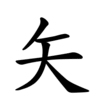矢
| ||||||||
Translingual
| Stroke order | |||
|---|---|---|---|
 | |||
Han character
矢 (radical 111, 矢+0, 5 strokes, cangjie input 人大 (OK), four-corner 80430, composition ⿱𠂉大 or ⿰丿天)
- Kangxi radical #111, ⽮.
Derived characters
- Index:Chinese radical/矢
References
- KangXi: page 823, character 34
- Dai Kanwa Jiten: character 23929
- Dae Jaweon: page 1235, character 22
- Hanyu Da Zidian: volume 4, page 2580, character 1
- Unihan data for U+77E2
Chinese
| simp. and trad. |
矢 | |
|---|---|---|
Glyph origin
| Historical forms of the character 矢 | |||
|---|---|---|---|
| Shang | Western Zhou | Shuowen Jiezi (compiled in Han) | Liushutong (compiled in Ming) |
| Oracle bone script | Bronze inscriptions | Small seal script | Transcribed ancient scripts |
 |
 |
 |
 |
| Characters in the same phonetic series (矢) (Zhengzhang, 2003) | |
|---|---|
| Old Chinese | |
| 彘 | *l'eds |
| 璏 | *l'eds, *ɢʷleds, *ɢʷled |
| 薙 | *l̥ʰiːs, *ljiʔ, *l'iʔ |
| 知 | *ʔl'e |
| 蜘 | *te |
| 智 | *ʔl'es |
| 鼅 | *te |
| 潪 | *teɡs, *deɡ |
| 踟 | *de |
| 雉 | *l'iʔ |
| 矢 | *hliʔ |
| 痴 | *l̥ʰɯ |
Pictogram (象形) - pictographic representation of an arrow. More recognizable in older forms.
Etymology
From Proto-Sino-Tibetan *d/s-ləy (“slingshot, bow (weapon)”) (STEDT). See here for cognates.
矢 (OC *hliʔ) shifted its meaning from the weapon to the projectile by means of metonymy.
Pronunciation
Synonyms
- (arrow): 箭 (jiàn)
Compounds
Japanese
Readings
Usage notes
Used in the Nihon Shoki (720 CE) as 借音 (shakuon) kana for ⟨si⟩.
Etymology 1
From Old Japanese. Found in the Kojiki of 712 CE, and in the Man'yōshū completed some time after 759 CE.[1]
Noun
- (archery, weaponry) an arrow
- c. 759, Man'yōshū (book 3, poem 364), text here
- 大夫之弓上振起射都流矢乎後将見人者語継金 [Man'yōgana]
- ますらをの弓末振り起し射つる矢を後見む人は語り継ぐがね [Modern spelling]
- masurao no yuzue furiokoshi itsuru ya o nochi mimu hito wa kataritsugu gane
- (please add an English translation of this example)
- 光陰矢の如し。
- Kōin ya no gotoshi.
- Shine and shadow, just like an arrow. → Time flies like an arrow.
- c. 759, Man'yōshū (book 3, poem 364), text here
- a wedge used to break hard objects such as wood or stone
- a 家紋 (kamon, “family crest”) with various designs of arrows
Derived terms
- 矢面, 矢表 (yaomote)
- 矢傷, 矢疵 (yakizu)
- 矢倉 (yagura)
- 矢印 (yajirushi)
- 矢継, 矢継ぎ (yatsugi)
- 矢壺, 矢坪 (yatsubo)
- 矢所 (yadokoro)
- 流鏑馬 (yabusame)
- 乙矢 (otoya)
- 落とし矢, 落し矢 (otoshiya)
- 差矢, 差し矢 (sashiya)
- 猟矢, 幸矢 (satsuya)
- 猟矢, 鹿矢 (shishiya)
- 素矢, 徒矢 (suya)
- 征矢 (soya)
- 止矢, 止め矢 (tomeya)
- 甲矢, 兄矢, 早矢 (haya)
- 弓矢 (yumiya, “bow and arrow”)
Etymology 2
| Kanji in this term |
|---|
| 矢 |
| さ Grade: 2 |
| kun’yomi |
From Old Japanese. Found in the Man'yōshū, completed some time after 759 CE.[3]
Possibly cognate with Old Japanese-derived 幸 (sachi, “a hunting implement”) and Korean 살 (sal, “arrow”).
This reading does not appear to be used in modern Japanese.
Noun
- (obsolete) an arrow
- c. 759, Man'yōshū (book 20, poem 4430), text here
- 阿良之乎乃伊乎佐太波佐美牟可比多知可奈流麻之都美伊埿弖登阿我久流 [Man'yōgana]
- 荒し男のいをさ手挟み向ひ立ちかなるましづみ出でてと我が来る [Modern spelling]
- arasi-wo no iwo-sa tapasami mukapi-tati kanaruma sidumi idete to a ga kuru
- (please add an English translation of this example)
- c. 759, Man'yōshū (book 20, poem 4430), text here
Korean
Vietnamese
Han character
矢 (thỉ, tẻ, thẻ, yêu, tử, tủ, tú, siệu)
- This term needs a translation to English. Please help out and add a translation, then remove the text
{{rfdef}}.
References
- Nom Foundation
- Thiều Chửu : Hán Việt Tự Điển Hà Nội 1942
- Trần Văn Chánh: Từ Điển Hán Việt NXB Trẻ, Ho Chi Minh Ville, 1999
- Vũ Văn Kính: Đại Tự Điển Chữ Nôm, NXB Văn Nghệ, Ho Chi Minh Ville, 1999